All three Field Ambulance Units (129th, 130th & 131st) of the now named 38th (Welsh) Division were now in Prestatyn to continue their Field and Hospital training. The arrival of approximately 650 RAMC men in Prestatyn was welcomed by many of the locals, as it provided a significant stimulus to local trade which was sorely needed as they had experienced a long period of slack trade since the outbreak of war. The Unit had its HQ in an empty house in Palmaira Gardens and the officers were put up at the Nant Hall Hotel. The routine of parades, physical exercise, marching drill and route marches continued. Col Davies took the Unit on a route march on the 4th March and not for the first time, managed to get lost, as 48128 Sgt Francis Sumption recorded. The Colonel was developing a reputation for not being very good at navigating!
By the 5th March, the Unit was about 228 strong and the process of inoculating the men against typhoid began with many of the men fainting when being injected! Not only that, but the inoculations made many of the men feel unwell for several days. However, by Monday 8th March most of the men had fully recovered and training resumed in earnest. 48135 C W Jarman was kept busy in the Unit office allotting regimental numbers to men who had not previously had one, as while most of the men of the Unit had joined back on December 12th, there was a steady trickle of men joining the Unit even at this stage.
On the 10th March more military clothing arrived for the men in the form of shirts and cardigan jackets but still they did not have their full military uniform.
The Unit was inspected by Col Probyn DSO at the 9am roll call parade who appeared very pleased with the way the Unit was shaping up.
The photograph below must have been taken after mid March as 48128 Sgt Francis Sumption records in his diary on the 11th that no tunics had yet been issued and the mens clothing was becoming very ragged. In fact, the uniforms for the men did not arrive until the 26th March.
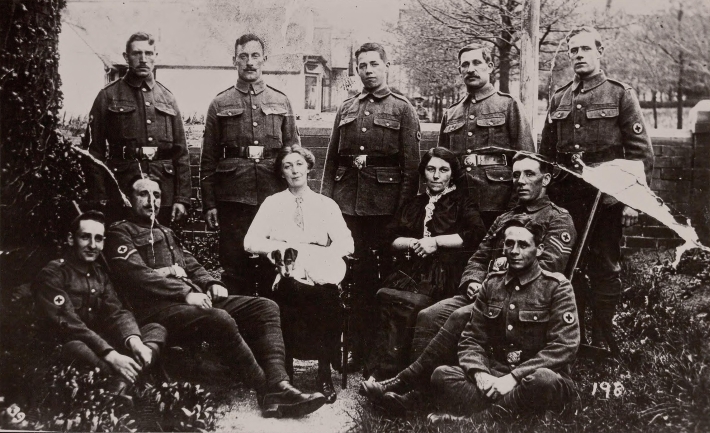
The photograph above is reproduced from the original held in the Army Medical Services Museum with a digital copy in the Welcome Library Collection. The landladies are two widowed sister – Mrs Evans and Mrs Schofield and the men of the 130th (St John) Field Ambulance are, back row left to right, 48122 Pte William Haysum, 48092 LClp John Brennan, 48180 Pte Timothy Richards (later awarded the M.M.), 48109 Pte Herbert Dobbs, 48024 Pte Issac Beecham (later DoW) and front row left to right, 48205 Pte W J Walters and 48162 Pte Samual Maxworthy – all from Mountain Ash and then Cpl Jones and 48551 Pte Hembry from Pontypridd.
While stationed at Prestatyn, the officers were billeted at the Nant Hall Hotel, in front of which the Unit photographs (see Home page and Official Photos page) were taken.
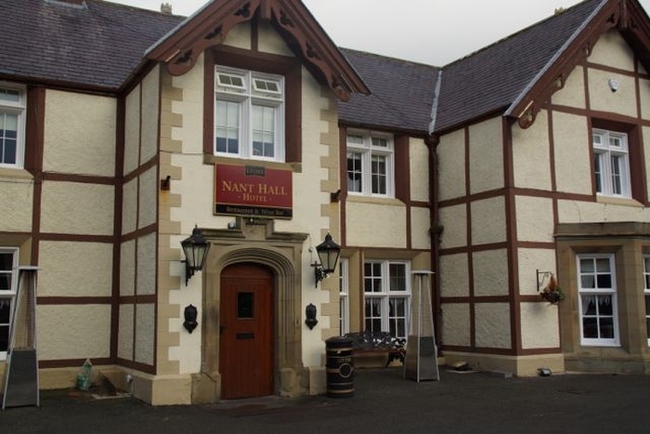
The training of the Unit continued at Prestatyn but equipment was in short supply to the extent that a carpenter in the Unit was making temporary stretchers so that the stretcher drill could become more interesting.
On the 13th March Colonel Probyn was sent to the Unit to take over from Colonel Davies. There had apparently been a disagreement between Dr Lyn Thomas (Welsh Army Corps Committee) and Herbert Lewis (Deputy Commissioner of No. 11 District, St John Ambulance Association) regarding the appointment of Officers to the Unit and the War Office had sent Col Probyn to take over from Col. Davies and also a Quarter Master Lieutenant from Aldershot to take over from Lt P S Thompson. There were rumours that Capt. A W Anderson and Major Edwards (both St John Ambulance Association Surgeons) were going to leave on account of Col. Davies losing his position. Neither Col Davies nor the other Officers of the Unit had yet been Gazetted nor had they received any pay to date.

Also, on the 13th March, 48594 Bugler James William Ward enlisted having obtained his St John Ambulance Certificate in January. The certificate is reproduced here with the permission of Bugler Ward’s niece, Mrs Jane Beecham.
Sunday the 14th March began with the normal Church parade and in the afternoon the six men pictured below went for a walk with the regimental mascot – Ginger (Lt Col Davies’ dog) and had their photograph taken.
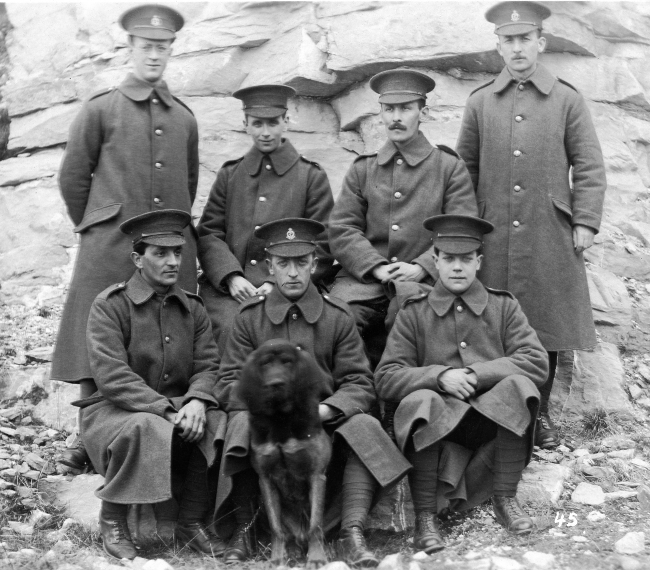
Another round of inoculations (or being ‘pipped’ as Sgt C W Jarman called it) occurred on the afternoon of Monday 15th and initially Col Probyn expected the men to parade again as usual the following morning and spend the day on light duties, but he later relented and allowed the men who had been inoculated to have the following day off duty.
By Thursday 18th, the men were still stiff after their inoculations and so the Unit went on a route march rather than having physical drill. It was a bitterly cold day and much of the march was done in a blinding snow storm. On this day, a new Quartermaster reported for duty with the Unit thus making Lieut Thompson’s position within the Unit uncertain.
On Friday 19th, Cpl Ernest Sweeting had to take a patient to Bangor Military Hospital and before he left, Capt Anderson asked him if he had any friends their to which he replied that he had as he had been in College in Bangor. Capt Anderson thus gave him a pass which allowed him to stay all day and told Cpl Sweeting not to hurry back. By this date, the other two field ambulances (129th and 131st) had received their uniforms but the 130th had still not received theirs. One of the jokers in the Unit had for a long time predicted that the Unit’s uniforms would arrive on the 3rd August and now stated that the sheep which are to provide the wool had already been selected. There was also concern in the Unit regarding the chances of leave over Easter (Easter Sunday 1915 was on the 4th April) as Col Probyn, who now appeared to be commanding the Unit, was not a believer in granting leave at any time except under very exceptional circumstances.
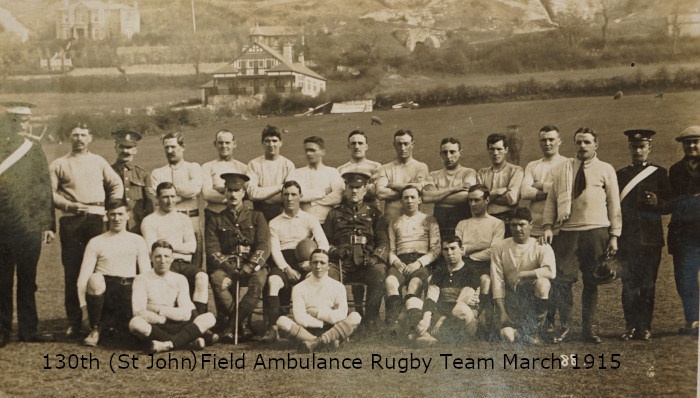
This is the earliest photograph we have of the Unit Rugby team. Taken sometime in late March 1915. The Officer seated in the centre of the group is probably Lt Col Probyn who was only Gazetted to the rank in March. 48071 Sgt/ Maj W Stroud can be seen standing far right in his St John uniform.
Sgt Jarman records that Lieut Thompson (the Unit’s Quartermaster) who was a keen mountain climber was also the owner of a very fine motor cycle and sidecar and on Sunday 21st March he invited Sgt Jarman out for a ride. He picked him up from his billet at 1.30 and returned him there at 7.30pm after a 90 mile round trip.
On Monday 22nd March, there was the usual early parade at 7.30 followed by physical drill, but no Officers turned up to the 09.30 parade and the Unit had to wait 30 minutes until Col. Probyn attended and assigned duties. There was a lot of ill feeling in the ranks such that on the following afternoon, the men (minus the NCOs) marched to the Nant Hall Hotel only to discover that Capt Anderson and Maj. Edwards had gone to London. Finding there was nothing else to be done, they marched back and dismissed themselves in an orderly manner. The next day at the 7.30 parade it was announced that the officers had gone on leave and this news quietened the men down a bit. The physical drill was now being conducted on ‘the field’ rather than on a by-road as had been the case until now.
The daily routine continued as before with physical drill after the 7.30am but now, at the 9.30 roll call, Col Probyn inspected all the men for tidiness etc.
Uniforms for the men of the Unit finally arrived on Saturday 27th March which was a great relief as many of the men had been wearing the suits they enlisted in back in December.
At the 7.30 parade on Monday 29th March it was announced that there was to be no general Easter leave and that ordinary leave will be curtailed. The men of the Unit were naturally very disappointed. Later the same day, the St John Ambulance men of the Unit had an examination to qualify for “Corps Pay” – an extra 4d per day.
Col. Davies, Maj. Edwards, Capt. Anderson and Lt Thompson were finally Gazetted on the 30th March.

L/Cpl Sweeting took the Unit for physical drill at the 7.30am parade on Wednesday 31st, while Sgt Owen was away on leave in Bedlinog. William Clifford Jarman was informed of his promotion to Sergeant (clerical section) and was moved from B to D section.
On Thursday 1st April, all four of the newly gazetted officers returned to the Unit and were greeted with loud cheers. 48128 Sgt Francis B Sumption recorded that “We are all very glad to see them back.” Col Probyn was appointed as an instructor to the Unit while Col Davies resumed his command, but on the 9th April, Col Probyn was appointed as Commanding officer of the 131st Field Ambulance and thus left Col. Davies to command the Unit. Sgt Sumption goes on to state that “Col. Davies is an extremely considerate sort of man although I think he is better as a doctor than as a Commanding Officer.”
Good Friday 2nd April 1915, the men of the Unit were dismissed for the day following the 9.30 roll call. On Easter Saturday the usual 7.30 parade and 9.30 roll call took place as usual and on Easter Sunday, the usual Sunday church parades occurred with the various denominations being marched to their appropriate places of worship.
On the 8th April, 48135 Sgt C W Jarman had been sent to Cardiff to collect an ambulance car, a gift of the St John Ambulance Association and he returned with it on the 9th.
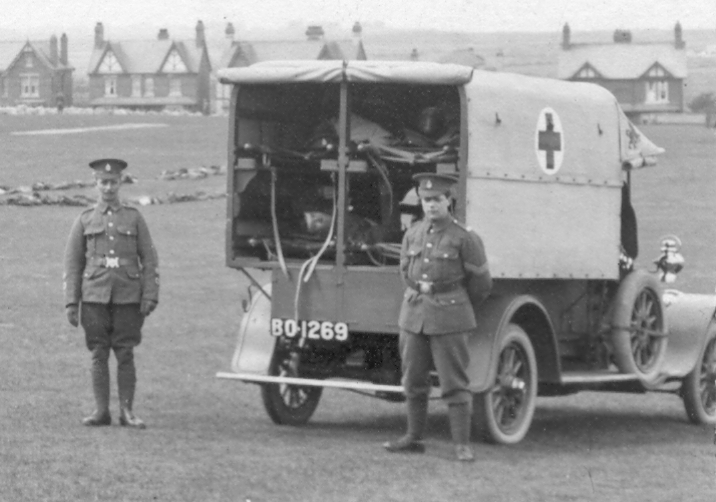
48071 Sgt Maj W Stroud standing to the left and 48135 Sgt C W Jarman to the right of the ambulance during a stretcher loading drill.
New recruits continued to report to the Unit and had to be processed by the orderly Sergeant and interviewed by the Colonel and then found billets. So even with the loss from the Unit of men who were found to be unfit for military service or were commissioned into other units (such as sergeant dispenser Arnold Collins from Swansea, who was commissioned into the 10th Welsh on the 3rd April, the total strength of the Unit gradually increased to well above its war time establishment. On the evening of the 12th April, four new recruits from York turned up, two of were probably 48620 Pte Martin Haddakin and 48619 Fred Yates, members of the Rowntree factory Ambulance Team in York.
As well as continuing their medical and military training while based at Prestatyn, the Unit had to provide a sergeant dispenser and nine hospital orderlies to the assist the Medical Officers of the infantry battalions (1st & 2nd Rhonddas, Carmarthen Pals and Swansea Pals) based at Rhyl. 48128 Sgt Francis B Sumption being tasked with this duty for two weeks starting on Saturday 17th April. During Sgt Sumption’s first week in Rhyl both 48192 L/Cpl Ernest Sweeting and 48087 L/Cpl Claude Trelawny Blackall were promoted to corporals. While Ernest Sweeting served the entire war with the Unit, later being promoted to Sergeant and being awarded the Military Medal for his actions at Pilckem Ridge in 1917, Claude T Blackall did not go to France with the Unit but transferred to the 22nd (County of London) Battalion The Queens and was commissioned into the 1st Monmouthshire in 1917.
Also, during this week the Unit photographs (see home page and Official Photos page) were taken outside the Nant Hall Hotel. Both 48128 Sgt F B Sumption and 48064 S/Sgt L W Williams are absent from the Officers and Sergeants photograph, Sumption because he was on duty in Rhyl and Williams because he was on leave in Cardiff during which time he became engaged.
During May, the men attended lectures on first aid and practice in bandaging and on the 13th were all marched down to the town hall in Prestatyn, where they each had an oral exam in first aid conducted in a small ante-room.
The next two images are with kind permission of David Ffoulkes, Grandson of Capt. Meredydd Ffoulkes who joined the Unit from the 16th (Service) Battalion of The Welsh Regiment (The Cardiff City Battalion) in June 1915.
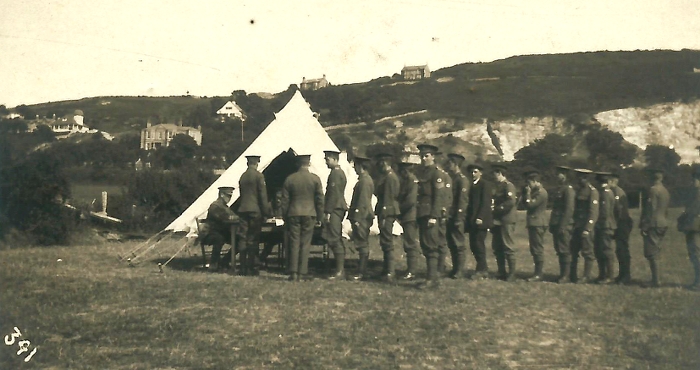
Note the man third from the end of the line still wearing civilian clothes, probably a new recruit.
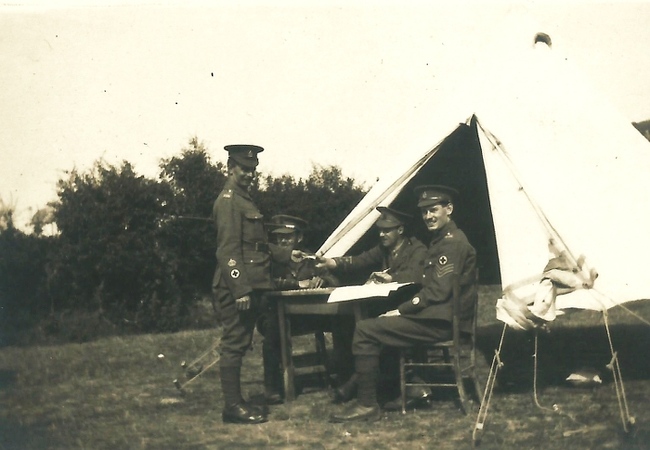
Capt. M Ffoulkes is seated at the entrance of the tent being handed a note by 48071 Sgt/Maj William Stroud.
On the 19th June, 48135 Sgt Clifford W Jarman, Sgt Evan Thomas Owen and 48128 Sgt Francis B Sumption were in charge of a large group of the men on a visit to the anatomical museum in Liverpool. Sgt Sumption describes the museum as “most disgusting and almost turned my stomach”.
With the coming of the longer days of summer, the first parade of the day had gradually been moved earlier and earlier and now took place at 6.30 am. With the arrival of ambulance wagons and the ambulance car the men’s training continued but, as can be seen from the picture below, there was still time for some larking about.
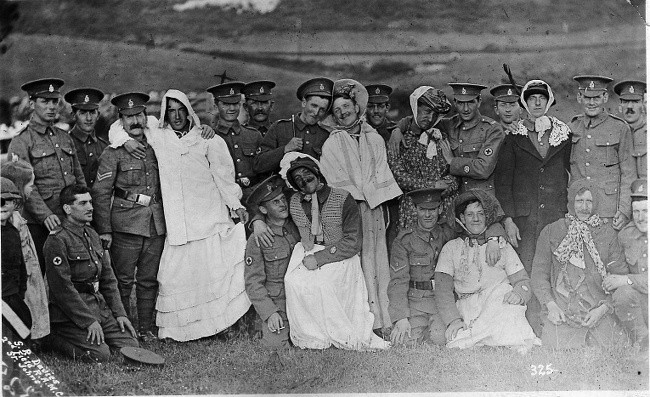
Larking about. Pte James Cleaves (X) and Pte Ridgeway (X)”
Image by kind permission of Helen Cleaves – Granddaughter of 48542 Pte James Cleaves.
By early July, Lieut. (later Capt.) Alfred John Andrew had joined the Unit and, as many of the Officers could not ride, there was a riding school for officers which provided much amusement for the men. Some like Major William B Edwards were experienced riders, but that did not stop him being thrown from his horse when it shied at a motor car in mid July. His broken leg sustained in the fall prevented him sailing to France with the Unit in December 1915, but he did eventually join the Unit again in late March 1916. When he was picked up, Major Edwards apparently said “I don’t care tuppence about a broken leg, but tumbling off a horse makes one look such a fool”.
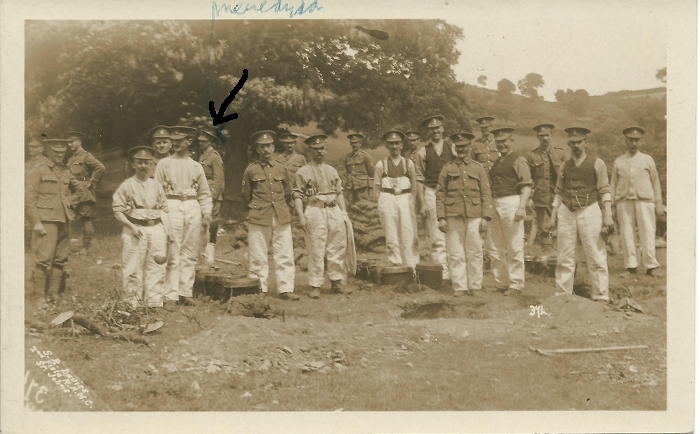
The photograph above is by kind permission of David Ffoulkes, Grandson of Capt. Meredydd Ffoulkes (arrowed). was taken at Geol Wood North Wales on the 21st June 1915. If anyone can identify any of the other men or has other information, please do get in contact.
On Tuesday 21st June, the Unit had a ‘Field Day’ and marched 8 miles to Geol Wood, south east of Prestatyn. The cooks of the Unit had camped out over night to prepare the food for the Unit.

48135 Sgt Clifford Jarman recorded that the sergeants had first to see that their sections were being fed and that there were no complaints and then they adjourned to their ‘Mess’ where a corporal waited on them (possibly 48087 Claude T Blackall). They were served Irish stew with potatoes, butter beans and a dab of ‘curried rice’ as an optional extra. Sgt Jarman didn’t like the look of the rice and so cried off describing it as a gastly looking concoction with the colour of a dandilion. Following the main course was a fruit salad and boiled rice and then biscuits and cheese washed down with a bottle of pop. The officers dined in their own mess with their wives and friends with a table to themselves. After diner the Unit choir under the command of Sgt Owen entertained them . At the end of the day the Unit marched back to Prestatyn by a different rout making the march about 15 miles in all.
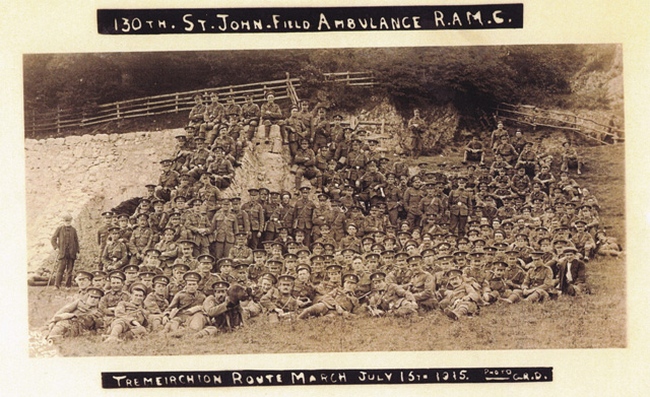
On the 26th July 1915 while still based at Prestatyn, the strength of the Unit was reported as a total of 266 all ranks (R.A.M.C., 6 officers, 18 Warrant Officers & Sergeants, 3 Buglers, 229 other ranks; A.S.C., 1 Sergeant, 9 other ranks). By the 2nd August, Lt F A Anderson had joined the unit.
On Thursday 5th August the Unit had a field training day at Downing Hall near Mostyn (a march of about 12 miles from Prestatyn) and 48128 Sgt Francis B Sumption was the NCO in charge of the hospital. The Unit arrived back in Prestatyn at 7.30pm having spent a long, tiring but enjoyable day.
On the 11th, the men of the Unit were issued with belts, but according to 48128 Sgt F B Sumption, they were second hand and some of them were smeared with blood!
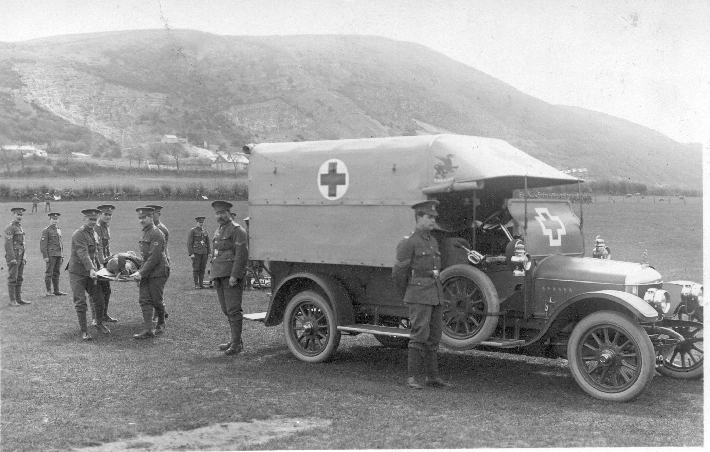
48135 Sgt Clifford W Jarman standing on the right at the front of the ambulance and 48068 Cpl Frank John King (later Sergeant and awarded the DCM for his actions at Pilckem Ridge in 1917) is standing immediately to the rear of the ambulance.
The Unit held a further field training day on Friday 13th August and returned from this in the pouring rain, arriving back in Prestatyn just in time for pay parade.
The Unit spent Wednesday 18th August moving out of their billets. The weather was glorious and they spent their time cleaning their belts with khaki blanco and laying them out on the grass of the field where they had previously practiced their stretch drill. At 8.30pm, they paraded at the Unit headquarters with all their belongings. A huge crowd of local people had gathered to wish the Unit farewell. Finally, the Unit marched to the station amid a blare of trumpets and boarded a train to Winchester via Chester, Shrewsbury and Birmingham.

Be the first to comment